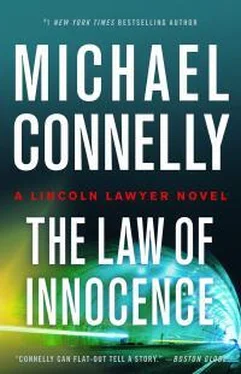On the bus, I was with thirty-nine other inmates, most of whom were heading to morning arraignment court. As a lawyer, I had seen the wide-eyed look of fear in clients when I met them for initial consultation at first appearances. But that was always in court and always with me calming and preparing them for what lay ahead. On the buses, I was surrounded by it. Men facing their first experience of incarceration. Men who had been in lockup many times before. Rookie or recidivist, there was a palpable sense of desperation coming from all of them.
I found the bus rides to and from court to be my own moments of biggest fear. It was random selection when you were loaded on. I had no Bishop, no bodyguard. Should anything happen to me, the deputies were behind an iron grate at the front: the driver and so-called safety deputy. Their role would be simply to sort out the dead and dying when whatever happened was over. They weren’t there to protect and serve, just to move people along in the underbelly of the justice system.
This time it was one of the modern buses with compartmentalized seating, the sight of which filled me with even more dread. The newer fleet was designed after there had been full-scale riots on buses that had raged out of control. With the Sheriff’s Department responsible for the safety of inmates, the riots resulted in scores of lawsuits against the agency for failure to protect those who had been injured and killed. I had lodged a couple of those lawsuits myself and so was aware of the weaknesses of the old and new designs.
The new buses were sectioned off by steel fencing into seating compartments of eight inmates each. This way, if a fight broke out, it was contained to a maximum of eight combatants. The buses had five such compartments and were loaded back to front, filling the seats in the rear section first and so on. The prisoners were cuffed together four to a chain, with one group on either side of the aisle in each compartment.
This design also was the blueprint for a significant problem. Should the bus be in transit and a fight break out in the rear compartment, the unarmed safety deputy must unlock and move through five doors and four compartments—four tight spaces filled with inmates accused in some cases of violent crimes—to break up a fight in the fifth. The idea was preposterous, and to my thinking, the department’s solution had actually doubled down on the problem. Fights in the rear compartments were allowed to play out until the bus got to its destination. Those who could walk off did and those who couldn’t were tended to.
The bus pulled into the cavernous garage beneath the Clara Shortridge Foltz Criminal Justice Center and we were off-loaded and escorted into the building’s vertical maze of holding cells that served its twenty-four different courtrooms.
As a pro se, I was entitled to some legal niceties not afforded most of the men and women who came off the buses. I was led to a private holding cell where I could confer with my investigator and stand-in attorney—the lawyer assigned as my backup to handle the printing, filing, and in some cases fine-tuning of motions and other documents produced as part of the case. My investigator was Dennis “Cisco” Wojciechowski and the stand-in was my law partner, Jennifer Aronson.
Everything moves slowly in incarceration. My 4 a.m. wake-up at Twin Towers resulted in me getting to my private conference room at 8:40 a.m., a total travel distance of four blocks. I had brought one rubber-banded stack of documents with me—the motions—and was spreading them on the metal table when my team was shown in by a detention deputy at nine sharp.
Cisco and Jennifer were required to sit across the table from me. No handshakes or hugs. The meeting fell under attorney-client privilege and was private. But there was a camera in one corner of the ceiling. We would be watched, but the camera carried no audio back to the deputy who monitored it—or so it was claimed. I didn’t fully believe this, and during prior team meetings I had occasionally made a remark or issued an order designed to send the prosecution off on a wild-goose chase if they happened to be illegally listening in. I used the code word Baja in each statement to alert my team to the ruse.
I was in dark blue scrubs with lac detention stenciled across the front and back of my shirt. Like Edgar Quesada the evening before, I wore long johns underneath. I had learned quickly during my stay with the county that the early-morning bus rides and courthouse holding cells were unheated, and I dressed accordingly.
Jennifer was dressed for court in a charcoal-gray suit and cream-colored blouse. Cisco, as was his routine, was dressed for a sunset ride down the Pacific Coast Highway on his classic Harley Panhead, Cody Jinks blasting on his helmet stereo: black jeans, boots, and T-shirt. It appeared that his skin was impervious to the cold, damp air of the conference cell. That he was originally from Wisconsin might have had something to do with that.
“How’s my team this fine morning?” I said cheerily.
Although I was the one incarcerated and wearing the jailhouse scrubs, I knew it was important to keep my people engaged and not worried about my predicament. Act like a winner and you’ll become a winner —as David “Legal” Siegel, my father’s partner and the man who mentored me in the law, used to say.
“All good, boss,” Cisco said.
“How are you doing?” Jennifer asked.
“Better to be in the courthouse than the jail,” I said. “Which suit did Lorna pick out?”
Lorna Taylor was my case manager as well as my sartorial consultant. This second duty extended from when she was my wife—my second wife, in a union that lasted only a year and preceded her marriage to Cisco. Though I would not be appearing this day before a jury, I had previously secured Judge Warfield’s approval of a motion allowing me to dress in my professional clothes during all appearances in open court. My case had drawn considerable attention from the media and I didn’t want a photo of me in convict garb going viral. The world outside the courthouse was a jury pool from which twelve people would be drawn to judge me. I didn’t want them, whoever they were, to have already seen me in jailhouse blues. My carefully curated selection of European suits also added to my confidence when I stood before the court to argue my case.
“The blue Hugo Boss with pink shirt and gray tie,” Jennifer said. “The courtroom deputy has it.”
“Perfect,” I said.
Cisco rolled his eyes at my vanity. I ignored it.
“What about the time?” I asked. “You talk to the clerk?”
“Yes, the judge slotted an hour,” Jennifer said. “Will that be enough?”
“Probably not, with argument from Dana. I might have to drop something if Warfield sticks to the schedule.”
Dana was Dana Berg, the Major Crimes Unit star prosecutor assigned to convicting me and sending me off to prison for the rest of my life. Among members of the downtown defense bar, she was known as Death Row Dana because of her propensity to seek maximum penalties, or, alternately, as Iceberg because of her demeanor when it came to negotiating pleas. The fact was that her resolve couldn’t be melted and she was most often assigned cases where trial was inevitable.
And that was the situation with me. The day after my arrest, I had put out a media statement through Jennifer that forcefully denied the allegations against me and promised vindication at trial. It was most likely that statement that got the case assigned to Dana Berg.
“Then what do we drop?” Jennifer asked.
“Let’s put bail on the back burner,” I said.
“Wait, no,” Cisco said.
“What? I wanted to go with that right out of the gate,” Jennifer said. “We need to get you out of there and into unrestricted strategy sessions in an office, not a cell.”
Читать дальше







![Майкл Коннелли - Christmas Even [Short story]](/books/390532/majkl-konnelli-christmas-even-short-story-thumb.webp)



